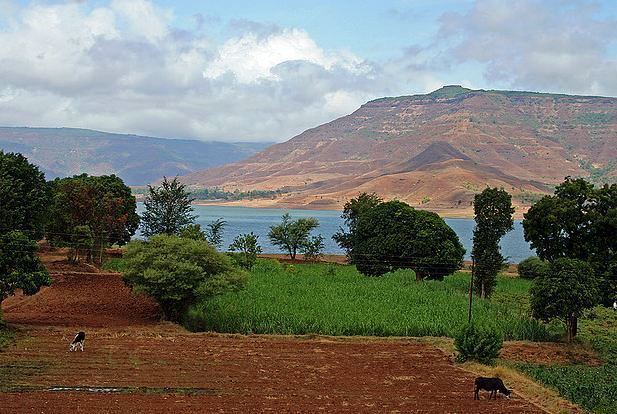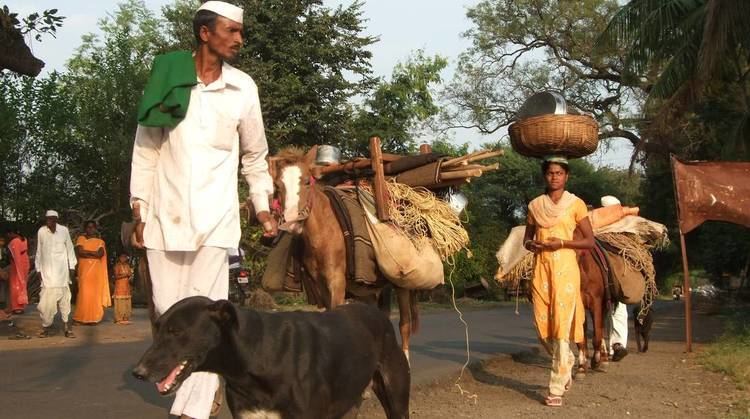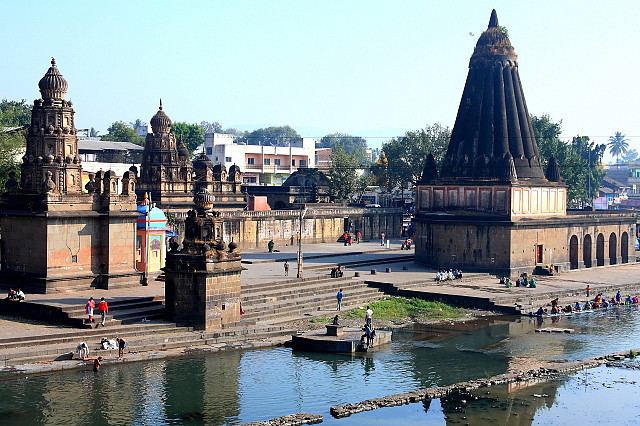Country State | Language spoken District | |
 | ||
Map of Wai, Maharashtra
Wai ( pronunciation ) is a town in Sātārā District, in Mahārāshtra state, India.
Contents
- Map of Wai Maharashtra
- Kashi vishweshwar mandir at wai maharashtra
- Menavali wai maharashtra www simplyoffbeat com
- History
- Geography
- Demography
- Culture
- Temples
- Education
- Tourist spots
- Infrastructure
- Notable residents
- References

Located on the Krishna River, Wai was a town of some prominence in the days of the Peshwas. Two important Maratha Brahmin from ruling families had their origins here: Rani Lakshmibai of Jhansi (Tambe family) and Gopikabai, wife of Nanasaheb Peshwa (Raste family). Peshwas, a word derived from the Persian word for "foremost leader," were similar to a modern prime minister, and served Maharashatra state from 1713 to 1857.

Wai has long been a cultural center. Locally prominent families built several architecturally significant temples in Wai. A few kilometers from Wai on a hill 4,650 feet above sea level is the temple of Mandhradevi Kalubai, which is more than 400 years old. In more recent times, some 300 Bollywood and Marathi movies have been filmed in Wai.

Kashi vishweshwar mandir at wai maharashtra
Menavali wai maharashtra www simplyoffbeat com
History
Wai has the epithetic name "Dakshin Kashi" (City of Temples) because of the city's more than 100 temples. Wai is known in Maharashtra for its ghats on the banks of the Krishna River and its temples, especially the Dholya Ganapati temple on Ganapati Ghat.
Pandavas established the site of the future city of Wai in the 1700s. The 17th century warlord Afzal Khan (general), representing Ali Adil Shah II of the Bijapur Sultanate, is said to have made his first halt here on his way to the fort of marahtha ruler Chhatrapati Shivaji Maharaj. A cache of 105 guns, swords and other weapons were found in Wai around 2005.
Geography
Wai is located at 17.94°N 73.88°E / 17.94; 73.88, approximately 35 km north of the city of Satara (Devanagari: satara). It has an average elevation of 718 metres (2355 feet). It is surrounded by the mountainous region of the Sahyādris.
Dhom Dam, west of Wai, was completed in 1982. Waters held by Dhom and Balakwadi dams, west of Wai taluka, surround the region's remaining small villages. Most residents of small villages moved elsewhere when dams were built. Dhom, Tasgaon, Aasgaon, Wyahli, Dhawli, Dahyat, Jor, Golewadi, Golegaon and Ulumb are major villages which were moved or lost because of the construction of man-made lakes. Nearly 16 km from Wai is the village of Borgoan, in middle of Dhom dam and Balkawdi dam, with four waterfalls. Borgoan's residents drink water from the falls year round.
Boundaries of Wai taluka: East of Wai are talukas of Khandala and Koregaon. To the west lies the taluka of Mahabaleshwar. The northern border abuts the Pune district. The north-west border is shared with the Raigad district. South of Wai are talukas of Jawali and Satara. A taluka is an Indian sub-district—smaller than a district and larger than a village.
Headquarters of Wai taluka is the city of Wai, populated by about 25,000 people. Wai is 35 km. from Satara, 95 km. from Pune, 250 km. from Mumbai. Situated on the Mahad-Pandharpur State Highway, Wai is a major city on the way to the hill stations of Mahabaleshwar and Panchgani.
Wai taluka has seven ghats on the Krishna's banks: Gangapuri, Madhi Aali, Ganpati Aali, Dharmapuri, Brahmanshahi, Ramdoh Aali and Bhimkund Aali.
Demography
According to a 2001 census in India, Wai had a population of 31,090. Males were 51% of the population; females, 49%. Literacy in Wai was 77%, (higher than India's national average of 59.5%). Male literacy was 81%; female literacy, 73%. As of 2001, 11% of Wai's population was under age 6.
Culture
The prominent Pradnya Path Shala (Devanagari: प्राज्ञ पाठशाला) educational institution is based in Wai.
Wai is well known for Tarkateertha Lakshman Shastri Joshi, founder of Marāthi Vishwakosh (Devanagari: विश्वकोश), an encyclopedia in the Marāthi language. Funded by the government of Maharashtra, the project began in 1960 and the first volumes were published in 1976. The encyclopedia is now available online free of charge.
Krishnabai Utsav is the main festival in Wai. When warlord Afzal Khan set out from Wai to attempt to defeat Chattrapati Shivaji Maharaj, Shendye Shāstri of Wai prayed to the Krishna River for Shivaji's victory, sparking the Krishnabai festival. It is celebrated on each ghat for four to eight days. The festival is also celebrated in the nearby town of Karad.
A 105-year-old Govardhan Sanstha (Goshala) celebrates Shri Krishna Janma Ashtami (Gokul Ashtami). The two-day Jatra festival attracts people from all over Maharashtra. The annual fairs, Yatras/Jatras, began with the Yatra of Mahalaxmi of Bhuinj, Jamb, Kikli and Belmachi on Dassraa. There are famous Yatras in the Wai taluka that is Mandhardevi, Bagad of Bavdhan, Kavathe, Kalambhe and Surur.
A number of movies have been filmed in Wai, including Jis Desh Mein Ganga Rehta Hain, Gangaajal, Omkara (2006 film), Dabangg 1, Dabangg 2, Swades, Ishqiya, Singham, Deool, Bol Bachchan, Zila Ghaziabad, Gulaab Gang, R Rajkumar, and Chennai Express, Bajirao Mastani. Others are Ardhasatya, 22 June 1897, Omkara (2006 film), Mrutyudand, Swades, Gangaajal, Dabangg and Gulaab Gang were shot in Wai and the nearby villages of Dhom, Bavdhan, Chikhli, Menvali, Bhuinj, Pachwad and the surroundings of Dhom, Balakwadi, Jambhali and Nagewadi dams.
Temples
Temples built in the Wai area tend to be built in Hemādpanti-style architecture. Use of huge stone slabs is the major characteristic of Hemādpanti architecture.
Four temples are near Brahmanshahi ghat: Chakreshwar, Chimneshwar, Kaunteshwar/Harihareshwar and Kaleshwar. Govardhan Sanstha ghat has Krishna Mandir. Near Brhmanshahi there are Vitthal and Ganpati temples. Ramdoh ghat has Rameshwar temple, Ramkund and Chilavali Devi temple. Gangapuri ghat has Lord Shiva, Dwarka, Bahiroba, Dattatray Temple. Ganpati Aali ghat has Ganpati and Kashi Vishveshvar temples. In Dharma Puri are Lord Vishnu temple and Mahalaxmi temple. Rokdoba temple (maruti) is built by Ramdas Swami. Dholya Ganpati temple is one of Maharashtra's prime temples. The large idol of Lord Ganesh is on Krishna River's ghats.
Hanuman Mandir is near Mahaganpati ghat.
Education
1.Blossom childrens academy ranks 1st in all schools at taluka level Some of other private tuition classes regarded as best of Maharashtra are Kalasagar Academy and Parth Classes
As well as Pradnya Path Shala, Wai has the following institutes:
